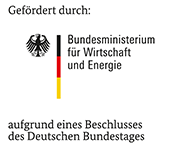17438 N

| Period: | 01.05.2012 - 30.06.2014 |
|---|---|
| Funder: | Federal Ministry for Economic Affairs and Energy via AiF |
| Project Manager: | Dr. Aneta Pashkova, Prof. Dr. Lasse Greiner |
| Research Group: | Chemical Technology |
Micro mixers are nowadays commercially available in various designs and materials. However choosing the right structure for a certain application is not always trivial. Both customers and producers are interested in proper characterisation techniques and good comparability of device performance. So far, characterisation of micro mixers in practice is carried out mainly by means of competing parallel reactions where chemical selectivity is dependent on mixing efficiency [1,2]. These reactive methods, however, suffer from experimental difficulties, as well as from the fact that the reference state of ideal mixing is experimentally not obtainable and therefore unsecured.
The method we propose has the advantage to use the enthalpy of mixing also called excess enthalpy (hE) as a reference state for complete mixing on molecular level, which can be obtained with good precision by means of (isothermal) calorimetry. On the other hand, heat balance calorimetry of the continuous mixing process in a micro structured device gives access to the apparent or effective excess enthalpy (hE,eff). The latter can than be normalised with hE yielding a dimensionless goodness of mixing (G) used for characterisation of mixing performance.
Focus of the research is the investigation of the performance of "static" mixing devices for non reactive fluid systems. Ethanol (EtOH) and acetone (AC) were chosen as model substances as they are relatively easy to handle, inexpensive, and readily available. Two micro structured mixers were initially characterised. The first one is a widely used and well studied example based on multilamination principle - a slit interdigital mixer (SIMM-V2, IMM, Germany). A T-type mixer (Valco Instruments, Switzerland) with 1.0 mm inner diameter was used for comparison.
Experiments were carried out in a reaction calorimeter with a Peltier based heat flux element (ChemiSens, Sweden). It was well suited for measuring hE in semi-batch mode by stepwise addition of thermally pre-equilibrated fluid to the charged fluid. These experiments were carried out to verify the experimental reference point. A good agreement with literature data for hE was observed [3].
For the continuous determination of hE,eff the mixers were installed within the reactor of the calorimeter. For the multilamination mixer G is constant within the experimental error. Generally, G is lower for the T-type mixer but shows a minimum at a molar ratio of 0.6. Probably, average diffusion length is shorter towards the lower or higher volume ratios, respectively. Whether this is an intrinsic effect of the mixer or caused by the peripherals is object of further investigations [3].
[1] Aubin, J., Ferrando, M., Jiricny, V., 2010. Current methods for characterising mixing and flow in microchannels. Chemical Engineering Science 65, 2065-2093.
[2] Panic, S., Loebbecke, S., Tuercke, T., Antes, J., Bokovic, D., 2004. Experimental approaches to a better understanding of mixing performance of microfluidic devices. Chemical Engineering Journal 101, 409-419.
[3] Pashkova, A., Greiner, L., 2012. Enthalpy of mixing for the determination of mixing efficiency of microstructured mixers by isothermal heat balance calorimetry. Chemical Engineering Science. doi:10.1016/j.ces.2012.03.029
back
Das IGF-Vorhaben Nr. 17438 N der Forschungsvereinigung DECHEMA e.V., Theodor-Heuss-Allee 25, 60486 Frankfurt am Main wurde über die AiF im Rahmen des Programms zur Förderung der industriellen Gemeinschaftsforschung (IGF) vom Bundesministerium für Wirtschaft und Energie aufgrund eines Beschlusses des Deutschen Bundestages gefördert.